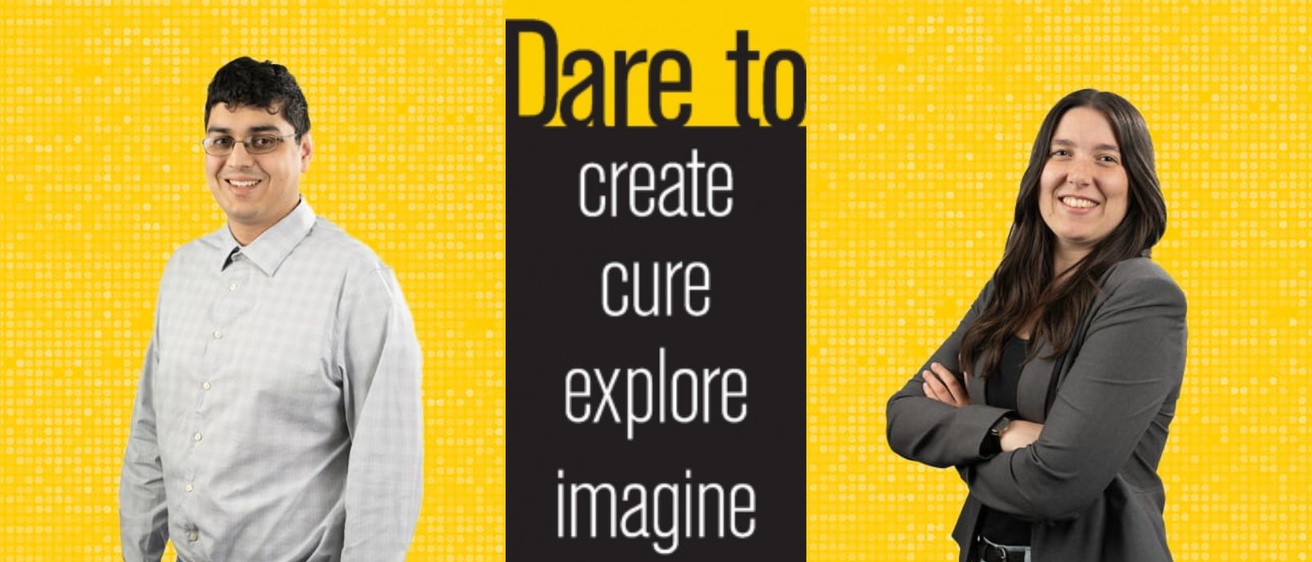Two Physics and Astronomy graduate students are featured in the 2023 University of Iowa Dare to Discover banner campaign.
Sanjay Chepuri and Cecilia Fasano are among 80 UI undergraduates, graduate students, and postdoctoral researchers and scholars in the Dare to Discover campaign, sponsored by the Office of the Vice President for Research. The ninth installation of the campaign showcases UI researchers, scholars, and creators on banners hung in downtown Iowa City from January to March 2024.
The featured researchers were selected from more than 200 nominations made by mentors, colleagues, and other members of the campus community. Profiles of each member of the 2024 cohort are available at dare.research.uiowa.edu.
Sanjay Chepuri, PhD student, physics and astronomy
Tracks energy in Earth's magnetic field
“Sanjay is a high-talent scientist. He is bringing new understanding to the Sun-Earth system through his scholarly work. But he is also very committed to creating an inclusive and welcoming environment.” -Allison Jaynes, associate professor
Hometown: Mukilteo, Washington
Faculty mentor/advisor: Allison Jaynes, PhD, associate professor, Department of Physics and Astronomy, College of Liberal Arts and Sciences
What is your degree program and anticipated graduation date? PhD in physics and astronomy, anticipated graduation in spring 2023
Please describe your research: I study Earth’s magnetosphere—the region surrounding Earth that is under the influence of Earth’s magnetic field. Specifically, I study data from NASA satellites to track high energy particles. This allows us to learn more about how our magnetosphere interacts with the solar wind and how energy flows through the entire magnetospheric system.
In simple terms, why does this research matter? We have only been able to measure the magnetosphere in situ for about 70 years, so there is still much to learn. The better we can characterize the magnetosphere, the better we can understand things like how solar flares will affect us on the ground and inside the magnetosphere or when we can expect to see different types of aurorae. The magnetosphere also gives us an opportunity to study plasma physics in different conditions than a lab that we can apply to other situations.
How soon after starting at the University of Iowa were you able to participate in research? I began participating in research in spring of my first year, about 8 months after starting here.
How has being involved in research made you more successful at the University of Iowa? Research is the most important part of my work as a graduate student here. So many people are doing great research in space physics here, which has allowed me a ton of opportunities to learn and grow as a researcher from different sources in addition to the opportunities I have had through my advisor.
What are your career goals and/or plans after graduation? After graduation, I plan on continuing with research in the same field, starting with a postdoctoral researcher position.
Cecilia Fasano, PhD student, physics
Crafts components for space telescopes
“Cecilia is truly an exceptional early-career scientist. Her research is a full-circle of fabrication, characterization, and deployment of grating technologies developed entirely in-house at the University of Iowa.” – Casey DeRoo, assistant professor
Hometown: Monmouth, Illinois
Faculty mentor/advisor: Casey DeRoo, PhD, assistant professor, physics and astronomy; and Keri Hoadley, PhD, assistant professor, physics and astronomy, College of Liberal Arts and Sciences
What is your degree program and anticipated graduation date? PhD in physics, spring 2025
Please describe your research: Using a number of techniques borrowed from the semiconductor and computer chip industry, I make components that will be used in future space telescopes. Currently, I use a beam of electrons to pattern structures only a few hundred nanometers wide, which make up a technology called a diffraction grating. Diffraction gratings spread out and direct light coming from stars, galaxies, and planets, unpacking it in a way that reveals the physics occurring throughout the universe.
In simple terms, why does this research matter? For astronomers, these technology improvements will enable future space-based missions, like the recently launched James-Webb Space Telescope, and allow us to looker deeper into space than ever before. In addition to applications in astronomy, a general improvement of our ability to make devices at nano- and micro-scale opens a world of advancements from biomedical applications to more efficient clean energy production.
How soon after starting at the University of Iowa were you able to participate in research? I started reading papers and working with my advisor during my very first semester at Iowa.
How has being involved in research made you more successful at the University of Iowa? I’ve met people in a variety of disciplines through my research at Iowa which has opened many doors for collaboration. This cross-disciplinary collaboration allows me to encounter challenging problems and continues to prepare me to be a contributing member of my scientific and professional communities.
What are your career goals and/or plans after graduation? I plan to seek a career in technology research and development which builds on the skills I’ve gained at Iowa. Ideally, this future work will focus on tackling a variety of real-world problems and contribute meaningfully to my community.
